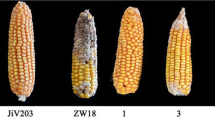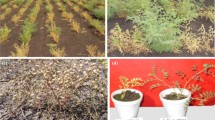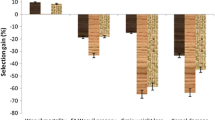Abstract
The pedigree method is often used for developing inbred lines in maize (Zea mays L.). This study was conducted to assess the effectiveness of pedigree selection for improving resistance to Gibberella ear rot in four maize populations. Selection was based on the severity of ear rot symptoms after inoculation with macroconidial suspensions of Fusarium graminearum (Schwabe) into the silk channel (for two populations) and into the developing kernels (for two other populations). Samples of the selfed families (S1 to S5), recovered from remnant seed from the selection programs, were evaluated for disease resistance during three years, using inoculation and evaluation protocols similar to those used during selection. Among-family selection was effective in both of the populations selected after silk inoculation and in one of the populations selected after kernel inoculation. Responses to selection were more evident in later than in earlier generations for both types of inoculation. Changes in the estimated genetic gain over generations were consistent with changes in the variances among families, which tended to increase in early generations and to decrease in later generations. Selection after kernel inoculation seemed to have been more effective than selection after silk inoculation in developing families with more stable resistance. Based on the results obtained here, it seems that responses to family selection could be accelerated without increasing operational costs by increasing selection intensity in later generations and inoculating fewer plants per family.
Similar content being viewed by others
References
Allard, R.W., 1960. Principles of Plant Breeding, Wiley, New York.
Bauman, L.F., 1981. Review of methods used by breeders to develop superior corn inbreds. In Proceedings of Corn Sorghum Industry Research Conference, Vol. 36, pp. 199–208.
Campbell, C.L. & L.V. Madden, 1990. Introduction to plant epidemiology. Wiley-Interscience, New York.
Chiang, M.S., M. Hudon, A. Devaux & I. Ogilvie, 1987. Inheritance of resistance to Gibberella ear rot in maize. Phytoprotection 68: 29–33.
Chungu, C., D.E. Mather, L.M. Reid & R.I. Hamilton, 1996. Inheritance of kernel resistance to Fusarium graminearum in maize. J. Hered 87: 382–385.
De León, C. & S. Pandey, 1989. Improvement of resistance to ear and stalk rots and agronomic traits in tropical maize gene pools. Crop Sci 29: 12–17.
Falconer, D.S. & T.F.C. Mackay, 1981. Introduction to Quantitative Genetics, 4th edn., Prentice Hall, Harlow.
Gendloff, E.H., E.C. Rossman, W.L. Casale, T.G. Isleib & L.P. Hart, 1986. Components of resistance to fusarium ear rot in field corn. Phytopathology 76: 684–688.
Gingera, G.R., D.W. Davis & J.V. Groth, 1994. Pedigree selection for improved partial resistance to common leaf rust in sweet corn. Crop Sci. 34: 615–620.
Hallauer, A.R., 1990. Methods used in developing maize inbreds. Maydica 35: 1–16.
Hesseltine, C.W. & R.J. Bothast, 1977. Mold development in ears of corn from tasseling to harvest. Mycologia 69: 328–340.
Hunter, R.B., G.N. Atlin & J.F. Muldoon, 1985. Genotype × environment interaction for ear mold resistance and its subcomponents in maize hybrids. Can J Plant Sci 66: 291–297.
Lew, A., A. Adler & W. Edinger, 1991. Moliniformin and the European corn borer (Ostrinia nubilalis). Mycotoxin Res 7: 71–76.
Ostle, B., 1963. Statistics in research: basic concepts and techniques for research workers. 2nd edn., Iowa State University Press, Ames.
Patterson, H.D. & E.R. Williams, 1976. A new class of resolvable incomplete block design. Biometrika 63: 83–92.
Prelusky, D.B., B.A. Rotter & R.G. Rotter, 1994. Toxicology of mycotoxins. In: J.D. Miller & H.L. Trenholm (Eds.), Grains: Compounds Other than Aflatoxin, Eagan Press, St. Paul, pp. 359–403.
Reid, L.M., R.I. Hamilton & D.E. Mather, 1996. Screening maize for resistance to Gibberella ear rot. Agriculture and Agri-Food Canada Tech Bull Publ 1996-5E.
Reid, L.M., G. McDiarmid, A.J. Parker, T. Woldemariam & R.I. Hamilton, 2001. CO388 and CO389 corn inbred lines. Can J Plant Sci 81: 457–459.
Reid, L.M., D.E. Mather, A.T. Bolton & R.I. Hamilton, 1994. Evidence for a gene for silk resistance to Fusarium graminearum ear rot of maize. J Hered 85: 118–121.
Reid, L.M., D.E. Mather, R.I. Hamilton & A.T. Bolton, 1992. Diallel analysis of resistance in maize to Fusarium graminearum infection via the silk. Can J Plant Sci 72: 915–923.
Reza Hoshmand, A., 1994. Experimental research design and analysis. A practical approach for agricultural and natural sciences. CRC Press, Boca Raton.
Sutton, J.C., 1982. Epidemiology of wheat head blight and maize ear rot caused by Fusarium graminearum. Can J Plant Pathol 4: 195–209.
Vigier, B., L.M. Reid, K.A. Seifert, D.W. Stewart & R.I. Hamilton, 1997. Distribution and prediction of Fusarium species associated with maize ear rots in Ontario. Can J Plant Pathol 19: 60–65.
Vigier, B., L.M. Reid, L.M. Dwyer, R.C. Sinha, J.T. Arnason & G. Butler, 2001. Maize resistance to Gibberella ear rot: symptoms, deoxynivalenol and yield. Can J Plant Pathol 123: 99–105.
Author information
Authors and Affiliations
Corresponding author
Rights and permissions
About this article
Cite this article
Presello, D.A., Reid, L.M., Butler, G. et al. Pedigree selection for Gibberella ear rot resistance in maize. Euphytica 143, 1–8 (2005). https://doi.org/10.1007/s10681-005-6149-0
Received:
Accepted:
Issue Date:
DOI: https://doi.org/10.1007/s10681-005-6149-0




